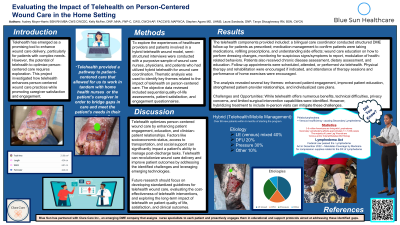Evidence-Based Practice
(EBP-018) Evaluating the Impact of Telehealth on Person-centered Wound Care in the Home Settting
Friday, May 2, 2025
7:45 PM - 8:45 PM East Coast USA Time

Cheryl Carver, LPN; Kristen Elizabeth Hameline, BSN; Kelly McFee, DNP; Jacqueline Mongusu, MSN; Audrey MoyerHarris, BSN; Erica Robinson, LPN; MyerAnn Royce Mangalino, DNP; Yisel Ruiz, MSN; Tanya Shaughnessy, BSN; Monica Trujillo, BSN
Introduction: Telehealth has emerged as a promising tool to enhance wound care delivery, particularly for patients with complex needs. However, the potential of telehealth to optimize person-centered care requires exploration. This project aimed to investigate how telehealth enhances person-centered wound care practices while also promoting caregiver satisfaction and engagement.
Methods: To explore the experiences of healthcare providers and patients involved in a hybrid telehealth wound model, semi-structured interviews were conducted with a purposive sample of wound care nurses, physicians, and patients who had utilized hybrid telehealth for wound care coordination. Thematic analysis was used to identify key themes related to the impact of telehealth on person-centered care. Objective data reviewed included sequential quality-of-life assessments, patient satisfaction, and engagement questionnaires.
Results: The telehealth components provided included: a bilingual care coordinator conducted structured DME follow-up for patients as prescribed; medication management to confirm patients were taking medications, refilling prescriptions, and understanding side effects; wound care education on how to perform dressing changes, monitoring for suspicious signs/symptoms to report, modulation of health-related behaviors. Patients also received chronic disease assessment, dietary assessment, and education. Follow-up appointments were scheduled, attended, or performed via telehealth. Physical therapy and rehabilitation were encouraged if indicated, and attendance of therapy sessions and performance of home exercises were encouraged.
The analysis revealed several key themes: enhanced patient engagement, improved patient education; strengthened patient-provider relationships; individualized care plans.
Challenges and Opportunities: While telehealth offers numerous benefits, technical difficulties, privacy concerns, and limited surgical intervention capabilities were identified. However, hybridizing treatment to include in-person visits can mitigate these challenges.
Discussion: Telehealth optimizes person-centered wound care by enhancing patient engagement, education, and clinician-patient relationships. Factors like socioeconomic status, access to transportation, and social support can significantly impact a patient's ability to manage post-discharge tasks. By addressing the identified challenges and leveraging emerging technologies, telehealth can revolutionize wound care delivery and improve patient outcomes.
Future research should focus on developing standardized guidelines for telehealth wound care, evaluating cost-effectiveness of telehealth interventions, and exploring long-term impact of telehealth on patient quality of life, satisfaction and clinical outcomes.
Methods: To explore the experiences of healthcare providers and patients involved in a hybrid telehealth wound model, semi-structured interviews were conducted with a purposive sample of wound care nurses, physicians, and patients who had utilized hybrid telehealth for wound care coordination. Thematic analysis was used to identify key themes related to the impact of telehealth on person-centered care. Objective data reviewed included sequential quality-of-life assessments, patient satisfaction, and engagement questionnaires.
Results: The telehealth components provided included: a bilingual care coordinator conducted structured DME follow-up for patients as prescribed; medication management to confirm patients were taking medications, refilling prescriptions, and understanding side effects; wound care education on how to perform dressing changes, monitoring for suspicious signs/symptoms to report, modulation of health-related behaviors. Patients also received chronic disease assessment, dietary assessment, and education. Follow-up appointments were scheduled, attended, or performed via telehealth. Physical therapy and rehabilitation were encouraged if indicated, and attendance of therapy sessions and performance of home exercises were encouraged.
The analysis revealed several key themes: enhanced patient engagement, improved patient education; strengthened patient-provider relationships; individualized care plans.
Challenges and Opportunities: While telehealth offers numerous benefits, technical difficulties, privacy concerns, and limited surgical intervention capabilities were identified. However, hybridizing treatment to include in-person visits can mitigate these challenges.
Discussion: Telehealth optimizes person-centered wound care by enhancing patient engagement, education, and clinician-patient relationships. Factors like socioeconomic status, access to transportation, and social support can significantly impact a patient's ability to manage post-discharge tasks. By addressing the identified challenges and leveraging emerging technologies, telehealth can revolutionize wound care delivery and improve patient outcomes.
Future research should focus on developing standardized guidelines for telehealth wound care, evaluating cost-effectiveness of telehealth interventions, and exploring long-term impact of telehealth on patient quality of life, satisfaction and clinical outcomes.

.jpg)